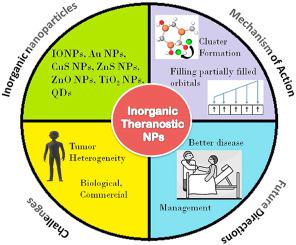当前位置:
X-MOL 学术
›
Mater. Today Chem.
›
论文详情
Our official English website, www.x-mol.net, welcomes your feedback! (Note: you will need to create a separate account there.)
Inorganic hybrid nanoparticles in cancer theranostics: understanding their combinations for better clinical translation
Materials Today Chemistry ( IF 7.3 ) Pub Date : 2020-12-01 , DOI: 10.1016/j.mtchem.2020.100381 A. Shetty , S. Chandra
Materials Today Chemistry ( IF 7.3 ) Pub Date : 2020-12-01 , DOI: 10.1016/j.mtchem.2020.100381 A. Shetty , S. Chandra

|
Abstract Drug resistance, tumor heterogeneity, and poor selectivity make cancer treatment with current modalities a challenging and complicated task. Careful planning of diagnosis and therapy is required to build new strategies for treatment and management of cancer. The amalgamation of therapeutics and diagnostics in a single nano agent, known as theranostics is now possible due to the emergence of nanotechnology. Theranostics offers opportunities for personalized medicine by real-time monitoring of drug accumulation and dynamic modification of treatment depending on individual patient needs. Thus potential to reform disease management is held by theranostic nanoparticles. Amongst other nanosystems, inorganic nanoparticles have been widely used for developing theranostic drug delivery systems due to their favorable intrinsic properties. The last decade has seen a surge in development of such theranostic nanoparticles in which various inorganic materials in different combinations have been engineered to maximize the output with respect to specific applications. For example, Fe3O4@Au nanoparticles were developed for MRI, hyperthermia and magnetically controlled drug delivery. Several such combinations leading to innovative theranostic applications and their underlying mechanisms have been highlighted in this review. A review of patents and clinical trials of inorganic theranostic nanoparticles is also presented through which we understood that clinical translation still remains in the nascent stage. Thus, it is necessary to find and understand reasons for lack of clinical translations. Therefore, we have discussed the challenges associated with bench-to-bed translation of such inorganic nanoparticles which show immense potential in vitro but fail to deliver in long run.
中文翻译:

癌症治疗学中的无机杂化纳米粒子:了解它们的组合以实现更好的临床转化
摘要 耐药性、肿瘤异质性和较差的选择性使当前模式的癌症治疗成为一项具有挑战性和复杂性的任务。需要仔细规划诊断和治疗,以建立新的癌症治疗和管理策略。由于纳米技术的出现,现在可以将治疗和诊断结合在单个纳米药物中,称为治疗诊断学。Theranostics 通过实时监测药物积累和根据个体患者需求动态修改治疗,为个性化医疗提供了机会。因此,治疗诊断纳米粒子具有改革疾病管理的潜力。在其他纳米系统中,无机纳米颗粒因其良好的内在特性而被广泛用于开发治疗诊断药物递送系统。在过去的十年中,这种治疗诊断纳米粒子的开发激增,其中设计了不同组合的各种无机材料,以最大限度地提高特定应用的输出。例如,Fe3O4@Au 纳米颗粒被开发用于 MRI、热疗和磁控药物输送。本综述重点介绍了几种导致创新治疗诊断应用及其潜在机制的此类组合。还介绍了对无机治疗纳米粒子的专利和临床试验的审查,通过这些审查,我们了解到临床转化仍处于初期阶段。因此,有必要找到并理解临床翻译不足的原因。所以,
更新日期:2020-12-01
中文翻译:

癌症治疗学中的无机杂化纳米粒子:了解它们的组合以实现更好的临床转化
摘要 耐药性、肿瘤异质性和较差的选择性使当前模式的癌症治疗成为一项具有挑战性和复杂性的任务。需要仔细规划诊断和治疗,以建立新的癌症治疗和管理策略。由于纳米技术的出现,现在可以将治疗和诊断结合在单个纳米药物中,称为治疗诊断学。Theranostics 通过实时监测药物积累和根据个体患者需求动态修改治疗,为个性化医疗提供了机会。因此,治疗诊断纳米粒子具有改革疾病管理的潜力。在其他纳米系统中,无机纳米颗粒因其良好的内在特性而被广泛用于开发治疗诊断药物递送系统。在过去的十年中,这种治疗诊断纳米粒子的开发激增,其中设计了不同组合的各种无机材料,以最大限度地提高特定应用的输出。例如,Fe3O4@Au 纳米颗粒被开发用于 MRI、热疗和磁控药物输送。本综述重点介绍了几种导致创新治疗诊断应用及其潜在机制的此类组合。还介绍了对无机治疗纳米粒子的专利和临床试验的审查,通过这些审查,我们了解到临床转化仍处于初期阶段。因此,有必要找到并理解临床翻译不足的原因。所以,



























 京公网安备 11010802027423号
京公网安备 11010802027423号